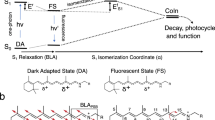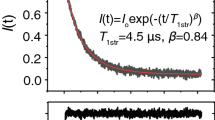Abstract
Chalazonitis and co-workers1 reported in 1970 that isolated frog rod outer segments in aqueous suspension can be oriented by a homogeneous magnetic field of 10 kG. The equilibrium orientation is parallel to the applied field. Furthermore, the two ends of a rod appear equivalent in a magnetic field. This latter observation suggested that the effect is either paramagnetic or diamagnetic. In either case, the effect can be due to (a) magnetic anisotropy, (b) “form” anisotropy, or (c) inhomogeneity of the applied field. The second and third mechanisms are ruled out, because the corresponding estimated magnetic potential (orientation) energy is not large enough to overcome thermal fluctuation. Numerical estimation based on the mechanism of magnetic anisotropy indicates that it is impossible to orient individual molecules in a rod with a field strength of 10 kG. However, two major molecular constituents, visual pigment rhodopsin and phospholipid, are oriented along the axial direction in a rod. If either molecule possesses a small anisotropy, the anisotropy will be additively summed in a rod and increased by a factor of 3 X 109 (rhodopsin) or 1013 (phospholipid). The crucial parameter is the summed anisotropy, which is the sum of the anisotropy of all the individual oriented anisotropic molecules, ∑ViΔXi, where ΔXi and Vi are the anisotropy of the volume susceptibility and the total effective volume of species i, respectively.
Access this chapter
Tax calculation will be finalised at checkout
Purchases are for personal use only
Preview
Unable to display preview. Download preview PDF.
Similar content being viewed by others
References
Chalazonitis, N., Chagneux, R., and Arvanitaki, A., 1970. Rotation des segments externes des photorécepteurs dans le champ magnétique constant. C. R. Aead. Sci. Ser. D. 271:130–133.
Hong, F. T., Mauzerall, D., and Mauro, A., 1971. Magnetic anisotropy and the orientation of retinal rods in a homogeneous magnetic field. Proc. Natl. Acad. Sci. USA 68:1283–1285.
Hong, F. T., 1973. On the importance of being ordered. II. Diamagnetic anisotropy in ordered biological structures. Ph.D. dissertation, The Rockefeller University, New York, Appendix 111:157–182.
Hong, F. T., 1977. Photoelectric and magneto-orientation effects in pigmented biological membranes. J. Colloid Interface Sci. 58:471–497.
Becker, J. F., Trentacosti, F., and Geacintov, N. E., 1978. A linear dichroism study of the orientation of aromatic protein residues in magnetically oriented bovine rod outer segments. Photochem. Photobiol. 27:51–54.
Chabre, M., 1978. Diamagnetic anisotropy and orientation of helix in frog rhodopsin and meta II intermediate. (Submitted for publication.)
Chagneux, R. and Chalazonitis, N., 1972. Evaluation de Tanisotropie magnétique des cellules multimembranaires dans un champ magnétique constant (segments externes des bâtonnets de la rétine de grenouille). C. R. Acad. Sci. Ser. D. 274:317–320.
Chagneux, R., Chagneux, H., and Chalazonitis, N., 1977. Decrease in magnetic anisotropy of external segments of the retinal rods after a total photolysis. Biophys. J. 18:125–127.
Chabre, M., 1975. X-ray diffraction studies of retinal rods. I. Structure of the disc membrane, effect of illumination. Biochim. Biophys. Acta 382:322–335.
Chabre, M., Saibil, H., and Worcester, D. L., 1975. Neutron diffraction studies of oriented retinal rods. Brookhaven Symp. Biol. 27(III),77–85.
Wiltschko, W. and Wiltschko, R., 1972. Magnetic compass of European robins. Science 176:62–64.
Geacintov, N. E., Van Nostrand, F., Becker, J. F., and Tinkel, J. B., 1972. Magnetic field induced orientation of photosynthetic systems. Biochim. Biophys. Acta 267:65–79.
Becker, J. F., Geacintov, N. E., and Swenberg, C. E., 1978. Photo-voltages in suspensions of magnetically oriented chloroplasts. Biochim. Biophys. Acta 503:545–554.
Gagliano, A. G., Geacintov, N. E., and Breton, J., 1977. Orientation and linear dichroism of chloroplasts and sub-chloroplast fragments oriented in an electric field. Biochim. Biophys. Acta 461:460–474.
Maling, J. E., Weissbluth, M., and Jacobs, E. E., 1965. Enzyme-substrate reactions in high magnetic fields. Biophys. J. 5:761–716.
Rabinovitch, B., Maling, J. E., and Weissbluth, M., 1967. Enzyme-substrate reactions in very high magnetic fields. I. Biophys. J. 7:187–204.
Rabinovitch, B., Maling, J. E., and Weissbluth, M., 1967. Enzyme-substrate reactions in very high magnetic fields. II. Biophys. J. 7:319–327.
Komolova, G. S., Erygin, G. D., Vasileva, T. B., and Egorov, I. A., 1972. Effect of a high strength constant magnetic field on enzymatic hydrolysis of nucleic acids. Dokl. Akad. Nauk SSSR Ser. Biol. 204:995–997.
Malinin, G. L, Gregory, W. D., Morelli, L., Sharma, V. K., and Houck, J. C, 1976. Evidence of morphological and physiological transformation of mammalian cells by strong magnetic fields. Science 194:844–846.
Nath, R. and Schulz, R. J., 1978. Modification of electron beam dose distributions by transverse magnetic fields. Medical Physics 5:226–230.
Rockwell, Sara, 1977. Influence of a 1400 gauss magnetic field on the radiosensitivity and recovery of EMT6 cells in vitro. Int. J. Radiât. Biol. 31:153–160.
Levine, M. A. and Ettienne, E., 1978. Coenzyme-dependent suppression of 2,2-PDS induced contractions in Spirostomwn. Microbios Letters 20:81–93.
Ettienne, E. and Dikstein, S., 1974. Contractility in Spirostomum provides for nonelectrogenic calcium regulation through energy-dissipative metabolic processes in the absence of membrane excitability. Nature (London) 250:782–784.
Dikstein, S. and Hawkes, R. B., 1976. Metabolically regulated cyclical contractions in microinjected Spirostomum: a pharmacological study. Experientia 32:1029–1031.
Ettienne, E. M., 1970. Control of contractility in Spirostomum by dissociated calcium ions. J. Gen. Physiol. 56:168–179.
Author information
Authors and Affiliations
Editor information
Editors and Affiliations
Rights and permissions
Copyright information
© 1979 Plenum Press, New York
About this chapter
Cite this chapter
Hong, F.T. et al. (1979). Magnetic Effects in Cellular and Molecular Systems. In: Tenforde, T.S. (eds) Magnetic Field Effect on Biological Systems. Springer, Boston, MA. https://doi.org/10.1007/978-1-4615-9143-6_5
Download citation
DOI: https://doi.org/10.1007/978-1-4615-9143-6_5
Publisher Name: Springer, Boston, MA
Print ISBN: 978-1-4615-9145-0
Online ISBN: 978-1-4615-9143-6
eBook Packages: Springer Book Archive




